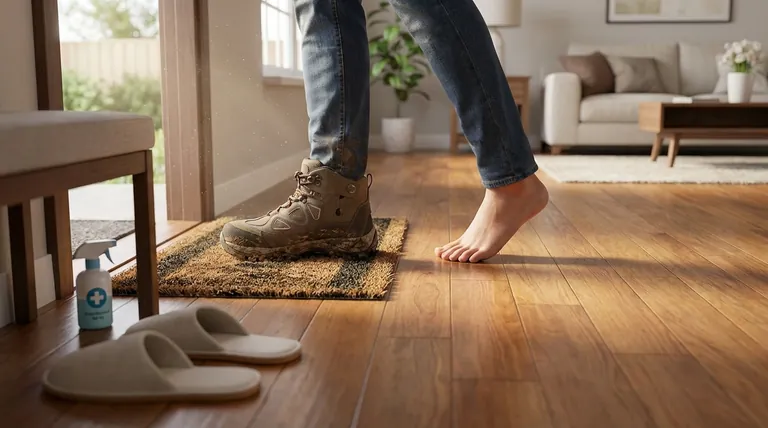The primary hygiene concern with wearing shoes indoors is the transfer of invisible contaminants from the outside world into your living space. Your shoe soles act as vectors for a host of harmful bacteria, allergens, and pollutants that can directly impact your home's cleanliness and your family's health.
The decision to wear shoes indoors is not just about visible dirt; it's a fundamental trade-off. You are choosing between protecting your feet from the indoor environment and protecting your indoor environment from outdoor contaminants.

The Contaminants You Track Indoors
When you walk outside, your shoes come into contact with a wide array of substances. Bringing them inside means bringing those substances into your home, where they can linger on floors and become airborne.
Harmful Bacteria and Viruses
Studies show that shoe bottoms are frequently contaminated with harmful bacteria. These microbes can survive the journey into your home and pose a risk, especially to young children or immunocompromised individuals.
Common bacteria found on shoes can cause serious illnesses, including intestinal and urinary tract infections, meningitis, and pneumonia.
Allergens and Pollutants
Shoes are magnets for outdoor allergens like pollen, grass, and mold spores. Once inside, these particles can settle into carpets and circulate in the air, triggering allergy and asthma symptoms.
This constant introduction of outdoor particles can significantly degrade your home's indoor air quality.
Fungal and Skin Infections
Public spaces like gyms or pools can harbor fungi and viruses that cause skin infections.
Wearing contaminated shoes indoors increases the risk of contracting and spreading conditions like Athlete's Foot or plantar warts within your household.
Understanding the Trade-offs
While the hygiene risks are significant, there are practical reasons why some people choose to wear shoes inside. Objectively weighing these points is key to making an informed decision.
The Case for Protection
Shoes act as a physical barrier. They protect your feet from injury by sharp objects, prevent slips and falls on slick floors, and reduce the pain of stubbing a toe on furniture.
The Need for Support
For individuals with foot conditions like plantar fasciitis or joint problems like arthritis, going barefoot is not an option. Proper footwear provides essential arch support and cushioning that is necessary for comfort and mobility.
A Barrier Against Indoor Grime
Paradoxically, shoes can also keep your feet clean from what is already on your floor. They create a barrier between your skin and any accumulated household dust, pet hair, or dirt.
Making the Right Choice for Your Goal
The best policy depends on your primary objective for your home environment.
- If your primary focus is maximizing hygiene: Implement a strict no-outdoor-shoes policy and ask guests to do the same.
- If your primary focus is foot support and safety: Invest in a comfortable pair of dedicated, "indoor-only" shoes or supportive slippers.
- If your primary focus is a practical balance: Place high-quality doormats at every entrance and create a designated, easy-to-use shoe removal area to contain outdoor dirt.
Ultimately, being mindful of what your shoes carry is the first step toward creating a cleaner and healthier home.
Summary Table:
| Concern Type | Key Contaminants | Potential Health Risks |
|---|---|---|
| Bacteria & Viruses | Fecal bacteria, E. coli | Intestinal infections, meningitis, pneumonia |
| Allergens & Pollutants | Pollen, mold spores, dust | Allergy flare-ups, asthma, poor indoor air quality |
| Fungal Infections | Athlete's Foot fungus, plantar warts | Skin infections that can spread within the household |
Ready to ensure a cleaner, healthier environment?
As a large-scale manufacturer, 3515 produces a comprehensive range of footwear for distributors, brand owners, and bulk clients. Our production capabilities encompass all types of shoes and boots, including dedicated indoor-only models designed for superior support and hygiene.
Let us help you provide the right footwear solutions for health-conscious consumers.
Contact 3515 today to discuss your manufacturing needs!
Visual Guide

Related Products
- Safety Footwear Wholesale Manufacturer for Custom OEM/ODM Production
- Advanced KPU Athletic Safety Shoe with Steel Toe Cap Anti-Slip Rotary Lacing System
- Premium Suede Sport Safety Shoes for Wholesale & Bulk Orders
- Heavy Duty Nubuck Safety Boots Safety Shoes for Global Distribution
- Premium Sport Style Safety Boots for Bulk Orders
People Also Ask
- How do safety shoes contribute to cost savings for companies? A Strategic Investment in Risk and Cost Management
- Is it normal to wear shoes in the house? A Guide to Hygiene, Comfort & Culture
- How long can you wear safety boots? The Lifespan is Determined by Wear, Not Time
- What are OSHA approved shoes? Understanding the Correct Standards for Workplace Safety
- What do heavy duty boots do? Protect Your Feet in Demanding Work Environments



















